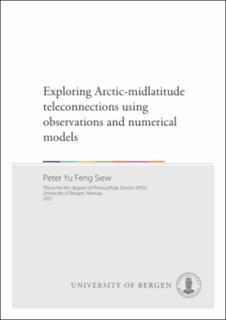| dc.contributor.author | Siew, Yu Feng | |
| dc.date.accessioned | 2021-05-25T08:58:13Z | |
| dc.date.available | 2021-05-25T08:58:13Z | |
| dc.date.issued | 2021-05-27 | |
| dc.date.submitted | 2021-05-19T14:02:26.137Z | |
| dc.identifier | container/4e/a7/14/66/4ea71466-1c0c-4625-8de4-991865d3d20f | |
| dc.identifier.isbn | 9788230856710 | |
| dc.identifier.isbn | 9788230843628 | |
| dc.identifier.uri | https://hdl.handle.net/11250/2756202 | |
| dc.description.abstract | The Arctic is warming at a much faster rate than the rest of the globe, with large declines in sea ice, snow cover and permafrost over the last decades. These profound changes have been proposed to influence the midlatitude atmospheric circulation in ways that lead to midlatitude extreme weather events that impact millions of people. Observational studies to date mostly support the existence of linkages from the Arctic to midlatitudes, but whether these linkages represent causal relationships is uncertain. Some modelling studies show that changes within the Arctic can influence regions outside the Arctic, but it is not clear how applicable these results are for understanding recent variability and trends in the midlatitudes. This thesis asks whether Arctic change has already had a noticeable effect on midlatitude circulation, and investigates the robustness of the proposed underlying mechanisms. It consists of four papers that employ a variety of tools including causal inference algorithms, comprehensive climate models and idealized general circulation models to address these research questions.
We used the Causal Effect Networks approach to test the robustness of a proposed pathway from autumn Barents-Kara sea ice to the winter North Atlantic Oscillation (NAO) via the stratospheric polar vortex (Paper I). Results show that the pathway is highly intermittent and less robust than previously thought. Given the possibility of an intermittent ice-NAO pathway in the real world, we investigated whether such a pathway also exists in state-of-the-art climate models (Paper II). Among bootstrapped samples of long climate simulations, a small number reproduce the observed relationship, but we find no evidence of a causal pathway. These results suggest that even an intermittent causal pathway is unlikely, and that the observed relationship is largely the result of internal variability. Taking one step back, the proposed ice-NAO causal linkage stems from the question of how the atmosphere adjusts to anomalous surface heating (associated with sea ice loss) in high latitudes. We performed idealized experiments with imposed surface heating over a range of latitudes (Paper III). Results show that midlatitude heating tends to generate circulation responses that act to offset the heating perturbation by horizontal advection, but high latitude heating does not. Finally, returning to sea ice itself, we investigate a proposed mechanism where Barents Sea ice retreat is hypothesized to influence cyclones tracks (Paper IV). The results show that the cyclone tracks are governed by the large-scale atmospheric flow rather than local sea ice conditions.
Overall, the findings in this thesis clarify the subtle effect of recent changes in the Arctic on the midlatitude circulation, and highlight the role of strong internal climate variability in modulating both the observed and simulated linkages. | en_US |
| dc.language.iso | eng | en_US |
| dc.publisher | The University of Bergen | en_US |
| dc.relation.haspart | Paper 1: P. Y. F. Siew, C. Li, S. P. Sobolowski, M. P. King, Intermittency of Arctic–midlatitude teleconnections: stratospheric pathway between autumn sea ice and the winter North Atlantic Oscillation. Weather and Climate Dynamics, 1, 261-275 (2020). The article is available at: <a href="https://hdl.handle.net/11250/2756193" target="blank">https://hdl.handle.net/11250/2756193</a> | en_US |
| dc.relation.haspart | Paper 2: P. Y. F. Siew, C. Li, M. Ting, S. P. Sobolowski, Y. Wu, X. Chen, North Atlantic Oscillation in winter is largely insensitive to autumn Barents-Kara sea ice variability. The article is not available in BORA. | en_US |
| dc.relation.haspart | Paper 3: P. Y. F. Siew, C. Li, S. P. Sobolowski, E. Dunn-Sigouin, Atmospheric response to midlatitude and high-latitude surface heating in an idealized moist general circulation model. The article is not available in BORA. | en_US |
| dc.relation.haspart | Paper 4: E. Madonna, G. Hes, C. Li, C. Michel, P. Y. F. Siew, Control of Barents Sea Wintertime Cyclone Variability by Large-Scale Atmospheric Flow. Geophysical Research Letters, 47, 1–11 (2020). The article is available at: <a href=" https://hdl.handle.net/11250/2740321" target="blank">https://hdl.handle.net/11250/2740321</a> | en_US |
| dc.rights | In copyright | |
| dc.rights.uri | http://rightsstatements.org/page/InC/1.0/ | |
| dc.title | Exploring Arctic-midlatitude teleconnections using observations and numerical models | en_US |
| dc.type | Doctoral thesis | en_US |
| dc.date.updated | 2021-05-19T14:02:26.137Z | |
| dc.rights.holder | Copyright the Author. All rights reserved | en_US |
| dc.contributor.orcid | 0000-0003-4163-4416 | |
| dc.description.degree | Doktorgradsavhandling | |
| fs.unitcode | 12-44-0 | |
